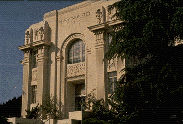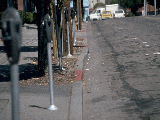This Day That Year
1840 - 1st postage stamps (Penny Black) issued (Great Britain)
1915 - German U-20 sinks Centurion SE of Ireland
1919 - Paris Peace Conference disposes of German colonies; Ger E Africa is assigned to Britain and France, German SW Africa to South Africa
1941 - Joseph Stalin became premier of Russia
1955 - West Germany joins NATO
1967 - Zakir Hussain elected 1st Moslem president of India
1988 - Graeme Hick scores 405 for Worcs v Somerset 35 fours 11 sixes
1991 - Space Shuttle STS 39 (Discovery 12) lands
1994 - Nelson Mandela and his ANC, finally confirmed winners in South Africa


 Note the change in the position of the curb from 1987 to the location in 1993 in the next picture
Note the change in the position of the curb from 1987 to the location in 1993 in the next picture
 Location in 1993
Location in 1993










 Clear evidence of fault creep is found in Fremont where Gardenia Way crosses the Hayward fault near Ivy. A sequence of fractures or shears forms diagonally across the asphalt pavement in the street.
Clear evidence of fault creep is found in Fremont where Gardenia Way crosses the Hayward fault near Ivy. A sequence of fractures or shears forms diagonally across the asphalt pavement in the street.

